Don’t live in a box!
→ Dandavats
Read More...
Websites from the ISKCON Universe
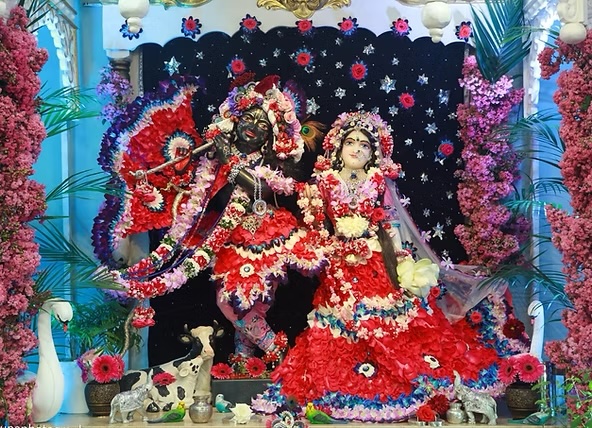
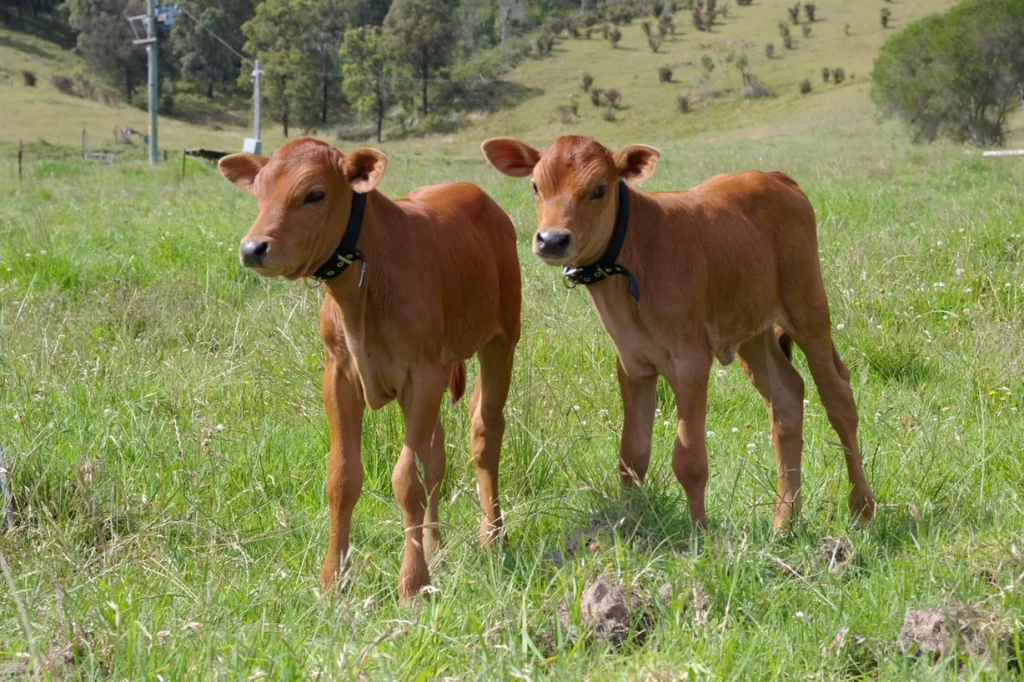
It was my pleasure to visit our New Gokula farm in Australia’s Hunter Valley, which is about two hours away from Sydney. Their Lordships, Sri Sri Radha Gokulananda, Jagannatha, Baladeva, Subhadra and Gaura Nitai are always beautiful to behold.
There has been a lot of improvement to the ashrama, cottages and other facilities on the property and even though not that many devotees live there, thousands of visitors come every week to take darshan of the deities and accept the tasty prasadam. I was also able to visit our restaurant in Newcastle, which was a great treat.


The post Hinduism and ISKCON under attack in Bangladesh – Four levels of response appeared first on The Spiritual Scientist.
The situation in Bangladesh is becoming increasingly grave, with minorities, especially Hindus, being threatened by elements that have gained significant power. The government is not doing much to protect these minorities. ISKCON has been accused of being a terrorist organization, and its members are being threatened. Several Hindu leaders, including a Krishna devotee, Chinmoy Krishna Das, have been arrested.
While radicalism, extremism, and fanaticism have slightly different connotations, in this article, they are used more or less interchangeably. I will address this issue from four distinct perspectives: philosophical, geopolitical, institutional, and individual.
Philosophical level
Many times, when such troubles come up, some people may say, “Oh, this is all politics. I don’t want to get involved.” But it depends on what we mean by the word politics. Politics has two distinct meanings. First, it has a neutral, functional meaning: the system, art, or science of governance. Second, it has a more negative connotation: the use of questionable or even reprehensible means, such as scheming, rumor-mongering, and character assassination to attain or retain power.
Those on a spiritual path should carefully avoid engaging in politics in the second sense. However, politics in the first sense—a system of governance—affects everyone. We may not be interested in politics, but politics is interested in us. Government policies, such as those related to taxation or laws that may be biased for or against certain groups, matter greatly. So too will governmental orientations toward religion, whereby they may make practicing our faith difficult or even impossible.
From a philosophical perspective, Krishna is not uninvolved in politics. In fact, when he descends to earth, one of his purposes is to bring about order in society, which is referred to as dharma (Bhagavad Gita 4.8). Such dharma refers to societal order and is distinct from shraddha (faith) or bhakti (devotion), which is personal and devotional. Krishna does not force everyone to become his devotee. For instance, on the Pandavas’ side during the Kurukshetra war, there were followers of Shiva who remained Shaivites. Similarly, on the Kauravas’ side, there were people like Bhishma who were Vaishnavas despite being on the side opposing the Pandavas.
The point is that Krishna’s mission of establishing dharma was not about imposing a particular faith on anyone. While Krishna does want us to become his devotees (18.66) and a government conducive to spiritual growth is desirable, he conveys in the Bhagavad Gita (4.9–10) that such growth must be individually chosen, not governmentally enforced. Nonetheless, the establishment of a basic societal order or dharma is a necessity, combating whatever threats may be present at different times throughout history.
One major threat to societal dharma today is radicalism, which can be understood in the context of the Bhagavad Gita as knowledge in the mode of ignorance (18.22). Radicalism reduces complex issues to a single attribute, ignoring the broader picture. Whether it arises from a secular ideology or a religious one, radicalism is a threat. For example, Marxism in Soviet Russia and China was highly reductive, targeting those considered unfaithful to the state, regardless of their other qualities or contributions. Similarly, religious fanaticism reduces people to one attribute—faith—and dehumanizes anyone who does not conform.
This reductionism erodes human sensitivity, decency, and humanity itself. Radicalism is thus an enemy of humanity, and it must be countered as a foundational necessity for human society. Religious extremism may seem to be a threat only to people who don’t follow that religion, but such extremism is a vicious and voracious monster; it will soon turn on its own. It will prey upon not only people of other religions but also people within the same religion who hold differing views of the same sacred text or teacher. For example, in Christianity, radical Catholics have targeted Protestants and vice versa. In Islam, radical Shias have persecuted Sunnis and vice versa.
Pertinently, the Srimad Bhagavatam describes how faith manifests in different modes of nature. It emphasizes that sattva-guna (goodness) fosters cooperation and harmony, whereas tamas (ignorance) is exclusivist, intolerant, separatist, and violent. Such faith disrupts societal harmony and fosters fanaticism. It is the responsibility of the state—its dharma—to prevent the surfacing of such tamasic faith. In this light, secularism, in the sense of a governing dispensation and disposition that allows people to practice their faiths peacefully, is not only compatible with dharma; it is integral to dharma.
Let us now examine where God is amidst such atrocities. Why does God not protect those devoted to him? God does protect, but he generally acts through human agents. He wants us humans to take responsibility to do our part. Krishna spoke the entire Gita to inspire Arjuna to play his part in the divine mission of establishing dharma. Arjuna’s faith in Krishna’s proclamation about his infallible protection (9.31) did not foster in him a passive dependence on God to do everything; far from it, it inspired in him a dynamic diligence to do all he could to fulfill God’s mission, as conveyed in his concluding declaration: “I will do your will.” (18.73). And as subsequently demonstrated by Krishna’s actions in the Mahabharata war, when Arjuna had done everything he could, Krishna did what Arjuna couldn’t — especially on the fourteenth day when he had taken a vow to neutralize Jayadratha.
Geopolitical level
Let us now examine this issue from a geopolitical perspective. Historically, the territories now comprising Bangladesh, India, and Pakistan were one. Ethnically, the people share significant similarities, as most Muslims in Bangladesh were originally Hindus who were converted, often forcibly. However, this shared history is overshadowed by the reductionism-triggered focus on a single attribute: faith.
Today, radical elements in Bangladesh target Hindus, portraying them as followers of the majority religion in India and therefore more faithful to India than to Bangladesh. However, this reduction ignores their shared heritage as people who have grown in the same cultural and ethnic milieu for generations. Pertinently, before Bangladesh gained independence, it faced persecution from religious extremists in Pakistan because Pakistani Muslims deemed Bangladeshi Muslims inferior due to their different ethnicity. It is ironic now that Bangladesh is embracing the very religious fanaticism it once fought against and forgetting its shared ethnic identity with Hindus — the very ethnicity for which it was previously targeted.
The geopolitical situation is further complicated by external influences. Some suggest that the American deep state (a network of influential government or non-government entities operating behind the scenes) played a role in overthrowing the previous government in Bangladesh. The U.S. government is poised for change, and the incoming dispensation may be more favorable to Hindu minorities in Bangladesh, given Trump’s supportive tweets and the presence in his inner circle of vocal and influential Hindus, such as Tulasi Gabbard and Vivek Ramaswamy. That’s why extremist elements may be seizing this opportunity to cause irreversible demographic damage to minorities before new U.S. policies exert pressure on the current regime.
Additionally, India needs to consider China’s vested interests in Bangladesh, given that it is located next to the Siliguri Corridor—the narrow “chicken’s neck” of India—which is India’s sole physical pathway to its northeastern states. If India becomes too aggressive toward Bangladesh, it may push the latter more into China’s embrace for security reasons, thereby jeopardizing Indian security. India must act cautiously, balancing national security concerns with its concerns for Hindus in Bangladesh.
Moving to the institutional perspective, we see how history demonstrates that significant changes often occur incrementally rather than through radical upheaval.
Institutional level
ISKCON has a global presence; yet it has spread much more widely than thickly. The number of its followers is not huge; it does not have a large political influence and historically it has not been involved in political concerns. In its relatively short history, it has not faced an existential threat to its community from religious radicalism the way it is facing in Bangladesh, where its cultural visibility makes it especially vulnerable during present volatile times.
Perceptions that ISKCON has disowned Chinmoy Krishna Das are misleading. The movement respects his rights as an individual and a faith leader, expressing concern for his safety. However, it has clarified that he does not currently represent ISKCON in an official capacity.
Balancing the safety of its broader community with standing up for justice for one particular member is a delicate challenge. In such volatile situations, the right course of action often becomes clear only with time. History shows that life sometimes presents no good options, and decisions must be made among unsatisfactory choices. As Krishna states in the Bhagavad Gita, all endeavors in this world are covered by faults, just as fire is covered by smoke (18.48).
When institutional actions seem incomprehensible, we may question whether they stem from malevolence (“Do the institution’s leaders not care at all for the members’ safety?”) or incompetence (“Do they not have the skills to deal with such high-stakes scenarios?”) or ignorance (“Do they not know how serious the problem is?”). However, there is a fourth possibility: we may be ignorant of the complexity of the situation. That’s why we may need to give the institution’s leaders the benefit of the doubt — especially when they are navigating uncharted territory while facing unprecedented challenges.
Finally, let us consider how individuals can respond in these challenging circumstances.
Individual level
Finally, let us consider how individuals can respond in these challenging circumstances. Our response depends on our position (guna) and disposition (karma). Regarding our position, those of us who are followers of Sanatana Dharma through the aegis of ISKCON may wonder about our identity—are we Hindus? At the transcendental (paramarthika) level, we are devotees of the one universal ultimate reality that we know by the name Krishna — this identity transcends all categories of identity in this world, including religious categorization in which Hinduism is one category. However, at a functional (vyavaharika) level, we will be identified as Hindus. While we may not label ourselves as such, extremists will see us as Hindus, often as highly visible representatives of Hinduism due to our external symbols.
Recognizing this reality, we have a responsibility to act when Hindus are threatened, what to speak of when fellow ISKCON members are targeted. ISKCON as an institution may not take a public stand for various strategic reasons, and its members may be constrained to some degree by the institution’s noncommittal position. Nonetheless, depending on the degree of their affiliation with the movement, individual members can express their personal concerns appropriately without making provocative, overgeneralizing statements about any religion or nation that can backfire on the entire community.
What kind of response can individuals choose? Drawing from the wisdom of our tradition and texts, our responses can range from equanimity to empathy. Equanimity helps us stay steady, recognizing that the world is filled with terrible events and that we cannot let ourselves be overwhelmed. Empathy allows us to connect with and support those who are suffering. The Bhagavad Gita emphasizes both qualities: equanimity as the characteristic of the self-realized in 2.56 and empathy as the hallmark of the topmost yogi in 6.32.
Those who feel strongly and gravitate toward empathy can engage in protests, rallies, or social media campaigns to exert political pressure. While the impact of such efforts may not be immediately visible, doing our part is essential. And we can wait for Krishna to do his part. Krishna states in the Bhagavad Gita that this world is a place of distress (8.15). Often, our choices are not between good and bad but between less satisfactory options. While most of us cannot bring about dramatic change in Bangladesh, we can decide how best to contribute within our capacity.
Conclusion
From a philosophical perspective, countering radicalism and fulfilling our human responsibility is essential for establishing dharma.
From a geopolitical perspective, patience and hope for incremental change are necessary.
From an institutional perspective, acknowledging the complexity of decisions made in volatile situations is crucial.
From an individual perspective, choosing responses that align with one’s position and disposition, ranging from prayerful equanimity to empathetic action, is significant.
Through these four levels, we can navigate this complex issue thoughtfully and constructively.
The post Hinduism and ISKCON attacked in Bangladesh appeared first on The Spiritual Scientist.
The post Hinduism and ISKCON attacked in Bangladesh – Four levels of analysis appeared first on The Spiritual Scientist.
Dear ISKCON Devotees, Please accept our humble obeisances. All glories to Srila Prabhupada. We are pleased to announce the ISKCON Leadership Sanga (ILS) 2025, hosted by the GBC, will take place from 17 – 20 February 2025 in Sridham Mayapur. The ILS 2025 is dedicated to fostering closer connections between the GBC and ISKCON leaders […]
The post GBC Announces ISKCON Leadership Sanga 2025 appeared first on ISKCON News.
Several associates of Lord Caitanya Mahaprabhu, the founder of Gaudiya Vaishnavism, were from present-day Bangladesh. The Bangladesh High Court on Thursday rejected a plea seeking to ban the International Society for Krishna Consciousness (ISKCON) in the country. The petition, filed by Supreme Court lawyer Md. Monir Uddin, cited newspaper reports alleging misconduct by ISKCON and […]
The post Bangladesh High Court Rejects Plea to Ban ISKCON appeared first on ISKCON News.
Middle and elementary school kids who participated in the “Dhruva” performance. Recently, the Duluth High School auditorium in Duluth, Georgia, USA, was transformed into a lively spiritual haven as GitaWise hosted its annual day celebration, an extraordinary event dedicated to the reverence of Lord Krishna. The event, attended by nearly 400 community members, featured over […]
The post Back to the Future: GitaWise Annual Day Celebrates Krishna’s Timeless Teachings appeared first on ISKCON News.
 If we are at all aware of how dependent we are on God—for the air we breathe, the water we drink, the food we eat, and our very ability to eat and drink and breathe, to think and feel and will, and to walk, talk, and sense—we will feel grateful and want to reciprocate God’s kindness. We will want to do something for He (or She or They) who has done, and continues to do, so much for us.
If we are at all aware of how dependent we are on God—for the air we breathe, the water we drink, the food we eat, and our very ability to eat and drink and breathe, to think and feel and will, and to walk, talk, and sense—we will feel grateful and want to reciprocate God’s kindness. We will want to do something for He (or She or They) who has done, and continues to do, so much for us.
We often take things for granted until we lose them. I use my right hand to chant on meditation beads, and one morning I found that I had severe pain in my hand and could no longer use it for chanting. I had taken the use of my hand for granted, but when I lost its use, I resolved to never take it for granted again and to always use it in the best way in God’s service.
How can we attempt to return some of God’s favor, some of God’s care and love for us? My spiritual master, Srila Bhaktivedanta Swami Prabhupada, gave one answer:
“Whatever you have got by pious or impious activities, you cannot change. But you can change your position, by Krishna consciousness. That you can change. Other things you cannot change. If you are white, you cannot become black, or if you are black, you cannot become white. That is not possible. But you can become a first-class Krishna conscious person. Whether you are black or white, it doesn’t matter. This is Krishna consciousness. Therefore our endeavor should be how to become Krishna conscious. Other things we cannot change. This is not possible.
tasyaiva hetoh prayateta kovido
na labhyate yad bhramatam upary adhah
tal labhyate duhkhavad anyatah sukham
kalena sarvatra gabhira-ramhasa
[Srimad-Bhagavatam 1.5.18]
Kalena, by time, you will get whatever you are destined. Don’t bother about so-called economic development. So far as food is concerned, Krishna is supplying. Eko bahunam yo vidadhati kaman. He is supplying even cats and dogs and ants. Why not you? There is no need of bothering Krishna, ‘God, give us our daily bread.’ He will give you. Don’t bother. Try to become very faithful servant of God. ‘Oh, God has given me so many things. So let me give my energy to serve Krishna.’ This is required. This is Krishna consciousness. ‘I have taken so much, life after life, from Krishna. Now let me dedicate this life to Krishna.’ This is Krishna consciousness. ‘I will not let this life go uselessly like cats and dogs. Let me utilize it for Krishna consciousness.’ ”
I pray that I will dedicate this life and everything I have—everything God has given me—fully in God’s service, following His pure devotees.
manasa, deho, geho, yo kichu mora
arpilun tuya pade, nanda-kisora
“Mind, body, and home, whatever may be mine, I surrender at Your lotus feet, O youthful son of Nanda!” (Bhaktivinoda Thakura, Saranagati)
Hare Krishna.
Yours in service,
Giriraj Swami
November 27, 2024 The International Society for Krishna Consciousness (ISKCON) expresses deep concern over the volatile situation in Bangladesh, particularly regarding the safety of Hindu minorities and members of our Hare Krishna ISKCON community. We urge all authorities to ensure the security and well-being of all citizens during this challenging time. We call upon the […]
The post Bangladesh Crisis Update appeared first on ISKCON News.

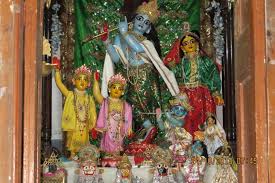
Sri Saranga Murari Thakura used to reside at Modadrumadwipa Mamagachi, where his Deities of Sri Sri Radha-Gopinath are still present. There is also a Bakula tree there which is perhaps existing since the time of Saranga Thakura. There is a local legend concerning this tree. One day when Mahaprabhu came there, He noticed that the Bakula tree in the courtyard of Saranga’s Temple was dying. So He asked Saranga, “This Bakula tree is dying, so what are you going to do?”
Saranga Thakura replied, “Besides Your mercy Prabhu, I don’t see any hope for this tree.” Then Mahaprabhu embraced that tree, which has remained healthy to this day and is now quite large.
Saranga Thakura had resolved that he would not accept any disciples but Mahaprabhu nevertheless repeatedly requested him to do so. Finally he relented and agreed by saying, “Tomorrow morning the first person I see I will initiate with the divine mantra.”
The next day, in the early morning, he went to take his bath in the Ganges. By chance a dead body came and touched his feet as he entered the water. Picking up this body he said, “Who are you? Get up.” From behind Mahaprabhu who was witnessing everything called out, “Saranga! Say the mantra in his ear!” Then when Saranga said the mantra into the ear of that dead child, the body became conscious. He said, “My name is Murari. I am your servant. Please bestow your mercy upon me.”
On the day when this boy was to be invested with the sacred thread he was by chance bitten by a snake and died. As he was only a boy, the custom was not to burn the body but rather to place it on a raft of banana trees and float it down the Ganga. When his parents received the news that their child was alive, they came there to take him home. However Murari declined to accompany them to his former home. He told them, “I will remain in the service of he who has given me life again, for I am indebted to him.”
According to Gaur-Ganoddesa-Dipika (text 172.) Saranga Thakura was previously Nandi Mukhi, in Braja lila.
vraje nandimukhi yasit
sadya saranga-thakkurah
prahlado manyate kaishchin
mat-pitraa na sa manyate
“The Vraja-brahmani Nandimukhi-devi appeared as Saranga Thakura. Some people think that Saranga Thakura was the incarnation of Prahlada Maharaj. My father (Sivananda Sena – the father of Kavi-karnapura) did not agree with them.”
His appearence is on the 14th day of the dark fortnight of the month of Asar. His disappearance is on the 13th day of dark fortnight of the month Agrahayon (Mrigashirsha – November-December).
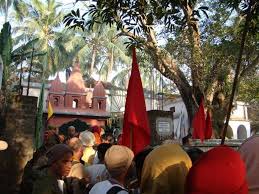
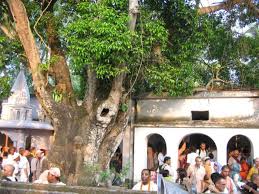
On the morning of November 26, 2024 (Bangladesh time), ISKCON Bangladesh released the following official statement: Statement from ISKCON Bangladesh regarding the current situation in Bangladesh and the arrest of Chinmoy Krishna Das We express our serious concern and strongly denounce the recent arrest of Chinmoy Krishna Das, spokesperson for the “Bangladesh Sammilito Sanatani Jagaran […]
The post ISKCON Bangladesh Releases Statement on Current Situation in Bangladesh and the Arrest of Chinmoy Krishna Das appeared first on ISKCON News.
The Gift Prabhupada Project is an initiative undertaken by a group of devotees to gift a miniature (54 mm) brass murti of Srila Prabhupada, particularly to his direct disciples. Alloyed within the brass murti are coins donated for Srila Prabhupada’s books from each of the 25 countries he personally visited, symbolizing the global impact of […]
The post Carrying Srila Prabhupada’s Mercy: The Gift Prabhupada Project’s Mission of Devotion and Gratitude appeared first on ISKCON News.
The post Hindi Wisdom from Ramayana When should a wrongdoer be blamed and when not blamed? appeared first on The Spiritual Scientist.
The post Hindi Wisdom from Ramayana When should a wrongdoer be blamed and when not blamed? appeared first on The Spiritual Scientist.
Bhakta Dasa at work on one of 20 large paintings inspired by the Bhagavad-gita As It Is. Photo courtesy: Sydney Morning Herald. Bhakta Dasa, Communications and Interfaith Director for ISKCON Australia and Australasia recently had his reflection entitled, “How a schoolyard bully set me on my spiritual path” published in the opinion section of The […]
The post Devotee Reflection Featured in Sydney’s Morning Herald Paper appeared first on ISKCON News.
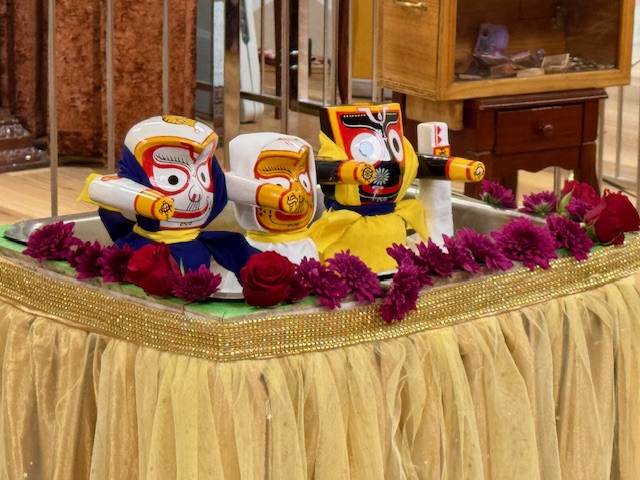

Perth temple celebrates Lord Jagannatha’s Rathayatra in the summer and the devotees observed the Lord’s Snana Yatra Festival a few weeks before.
According to Skanda Purana, when King Indradyumna installed the wooden deities he arranged this bathing ceremony. This day is considered to be the birthday of Lord Jagannatha. After the ceremony, the deities are not seen for a fortnight. The deities are kept in a special “sick room” and looked after by the pujaris.
It was my good fortune to participate in the Snana Yatra and associate with the many devotees who came to bathe Lord Jagannatha, Balarama and Subhadra on this auspicious occasion.

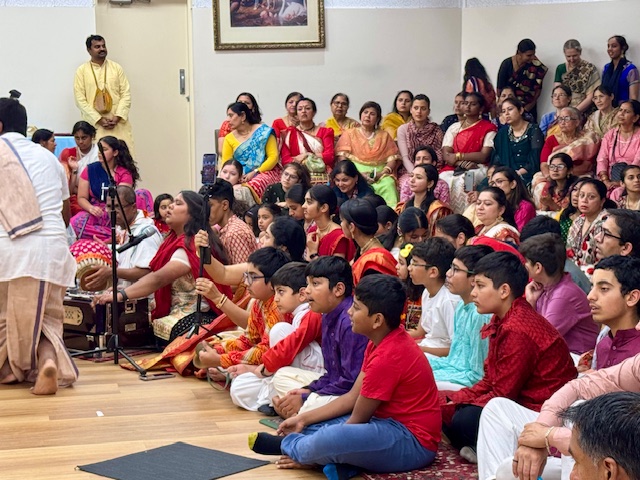
Vrajmohan Das has crafted a unique board game, “To Every Town And Village,” inspired by the classic game Monopoly. As the name suggests, the goal of the game is to help sponsor temples, develop projects, and spread Srila Prabhupada’s mission to every corner of the globe. Blending elements of fun, strategy, and devotion, the game offers […]
The post Explore ISKCON’s Legacy with the Board Game ‘To Every Town And Village” appeared first on ISKCON News.
Recently, a vibrant interfaith program took place at St. Alban’s Cathedral, bringing together individuals from various religious backgrounds to share their faiths to foster understanding, and work towards a stronger, more harmonious community. This event was a testament to the power of dialogue and mutual respect, where members of different traditions had the opportunity to […]
The post Building Bridges at St. Alban’s Cathedral appeared first on ISKCON News.
Since many of our ISKCON congregational members are of South Asian Indian descent and may be interested in participating in this program described below, we are publishing this story. We recognize it’s not relevant or open to many of our readers. However, because a sizable number may be interested in this opportunity to visit India […]
The post Indian Embassy Invites Diaspora Youth to Explore India Through its KIP Initiative appeared first on ISKCON News.
Guruttama Dasa, in gold, on President Alexander Stubb’s left, along with other key religious leaders at the Presidential Palace. On November 19, 2024, Guruttama Dasa, one of the managers of ISKCON Finland, attended an important meeting at the Presidential Palace in Helsinki, hosted by the President of Finland, Mr. Alexander Stubb. The gathering brought together […]
The post ISKCON Invited to President of Finland’s Meeting with Religious Leaders appeared first on ISKCON News.
ISKCON’s North American Leadership Conference was held October 4-6th at New Vrindaban, West Virginia, gathering over 120 leaders from across the continent. Sankirtana Dasa, a long-time resident of NV, reflects on its relationship to Srila Prabhupada’s mood and mission, his experience and realizations attending some of the sessions, and insights from interviews with leaders over […]
The post The North American Leadership Conference: An Inspired Step Forward appeared first on ISKCON News.
The post 1 When Supersoul speaks | Four worldviews analyzed appeared first on The Spiritual Scientist.
Premanjali holding one of her signature Learn Kirtan harmoniums. Kirtan, the sacred practice of chanting and singing the names of The Supreme Personality of Godhead, Sri Krishna, is a profound tool for meditation and self-expression. For Premanjali Dasi, kirtan is not only a complete devotional activity but also a transformative experience she aims to make […]
The post Kirtan for Everyone: Premanjali Dasi Aims to Spread Devotional Joy appeared first on ISKCON News.